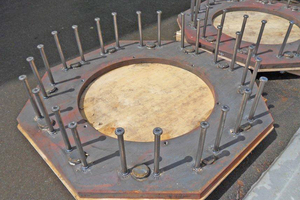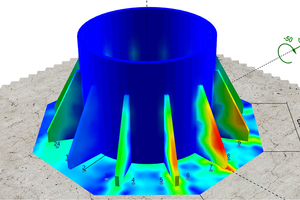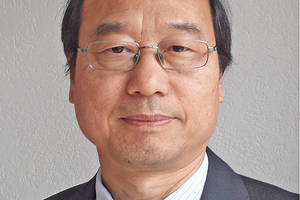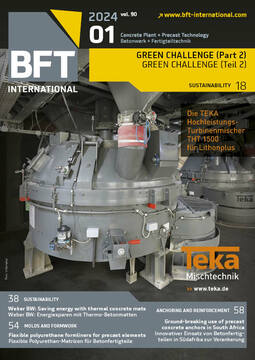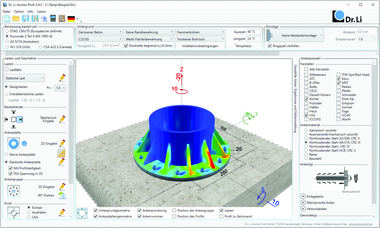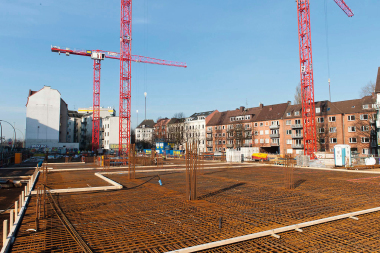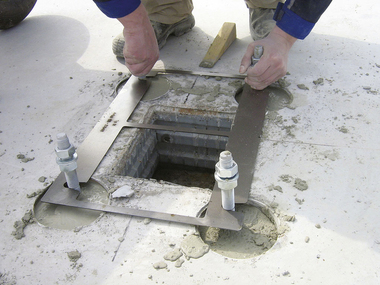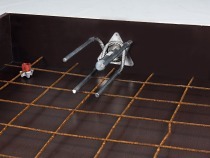Interview: New model for realistic design of elastic
anchor plates
With the Anchor Profi design tool from the German software house Dr. Li Anchor Profi GmbH, structural engineers can compute which dowels or headed bolts are adequately reliable for fastening their extension elements – also to customarily used non-stiff base plates. Until now, the code had specified that base plates must be of sufficient stiffness, which resulted in extremely large thicknesses. For the customary thinner (but more economical, non-stiff) thicknesses, the dowel forces computed for stiff base plates significantly deviate from the dowel forces calculated for non-stiff base plates. The result becomes imprecise and can lead to the use of over-dimensioned dowels.
The design specialist Dr. Longfei Li has now succeeded in solving this challenge mathematically, thus minimizing possible damage risks. Reason enough for the anchorage fastening technologist Dr. Jürgen Stork to designate Dr. Li’s computational model as the second major breakthrough in dowel technology.
BFT International: Dr. Stork, engineers must demonstrate that extension elements that are fastened to concrete with dowels or headed bolts will durably and reliably hold. How difficult are computations of this kind?
Dr. J. Stork: There is a code that demonstrate methods for performing the required analyses, whereas manual checking in individual cases is time-consuming – therefore the trend toward software-supported solutions. The loadbearing capacities and the deformation of dowels are summarized in European assessments. Some loadbearing and deformation values can be determined numerically. In manual and software-supported solutions, the dowel forces are determined based on the external loads in an initial step. In the second step, the verifications are performed with the loadbearing capacities of the relevant European Technical Assessments – ETA – in accordance with the codes for these forces. Until now, no design concept coordinated with mechanical principles has been developed. This results in a number of regulations with some exceptions and makes verification of anchorage engineering complex.
BFT International: International standards – such as DIN EN 1992-4, as Part 4 of Eurocode 2 – require that base plates must be sufficiently flexurally rigid. However, materials in service behave elastically under the action of tensile loading and transverse forces. Is there, in your view, a residual risk?
Dr. J. Stork: Choice of a sufficient thickness can satisfy the specification of the standard. Currently, the standard is being revised and/or supplemented, and criteria for the term “sufficiently rigid” are, among other things, being worked out. Whether this will lead to thicker base plates remains to be seen on a case-to-case basis.
BFT International: Anchor Profi has specialized in the phenomenon of the elasticity of base plates. With this tool, dowel performance can be quickly and precisely designed, for products of all market-relevant manufacturers. What is the added value?
Dr. J. Stork: This software enables engineers to utilize typically-used thin base plates. It integrates the no longer planar distribution of the dowel forces into the computational model. This method is not covered by the relevant regulatory framework. My colleague Dr. Li has shown in publications that it seems to function.
BFT International: You have called this model the second major breakthrough. Why?
Dr. J. Stork: What was the first major breakthrough? Until the mid-80s there existed for practical use only dowels suitable for uncracked anchorage substrates (concrete in State I, editor’s note). Dowels in uncracked anchorage substrates have greater loadbearing capacity than do dowels in a cracked anchorage substrate (concrete in State II, editor’s note). In State I, the loadbearing capacity is higher by approx. 30 %. Toward the end of the 80s, dowels suitable for the cracked anchorage substrate became standard.
BFT International: What was so significant about that?
Dr. J. Stork: The fact that the manufacturers and the standardization bodies agreed on cracked anchorage substrate as standard, and that dowels suitable for use in cracked substrate were developed.
BFT International: And the realistic fastening design of elastic base plates will lead to the next turning point?
Dr. J. Stork: Yes, that is the second major change in dowel engineering. If cost-efficient base-plate thicknesses are desired, a base plate can no longer be sufficiently stiff in the sense of the code. As a result, a concrete breakthrough model is needed that considers non-planar distribution of the dowel forces. In this context, Dr. Li found a detail in the Guideline for European Technical Approval of Metal Dowels for Anchorage In Concrete (DIBt Mitteilungen 31.12.1997), based on which insufficiently rigid base plates can be designed. That is his achievement. Consequently, he is the first who developed generally accessible software for this purpose, for which he deserves great admiration and respect.
BFT International: Therefore, the previous concrete breakthrough model is no longer suitable?
Dr. J. Stork: The current concrete breakthrough model of the code calls for linear distribution of dowel forces. In some cases, that can lead to uneconomically thick base plates. If that is not desired and thinner base plates will be selected, a concrete breakthrough model that takes the new distribution of dowel forces into account is needed.
BFT International: Now Anchor Profi can reliably design typically used thin base plates. And it is possible to quickly compute which dowel is best-suited for an anchorage, regardless of the manufacturer. What does that mean for users?
Dr. J. Stork: Users will be provided with a technically correct solution that, although not in conformity with the codes, meets all essential criteria in terms of cost-efficiency, reliability and verifiability. When software users independently confirm by calculation the data of the model itself shown in the printout of the Anchor Profi, they will come up with Dr. Li’s result. That is what you call quality. Software tools of other manufacturers, for example, do not always inform users of the stiffness of the spring of the dowel, so that the result can no longer be confirmed by recalculation. Here, Dr. Li’s work is transparent. Users can decide which dowel system they wish to use from the manufacturer they wish for their project. This is because this process assures the optimum among loadbearing capacity, processability, edge distances etc. This comparability offers a huge advantage with respect to engineering expertise and cost effectiveness.
BFT International: Dr. Stork, we thank you for your time.
CONTACT
Dr. Li Anchor Profi GmbH
Gustav-Stoll-Weg 7
72250 Freudenstadt/Germany
+49 7441 4073833

